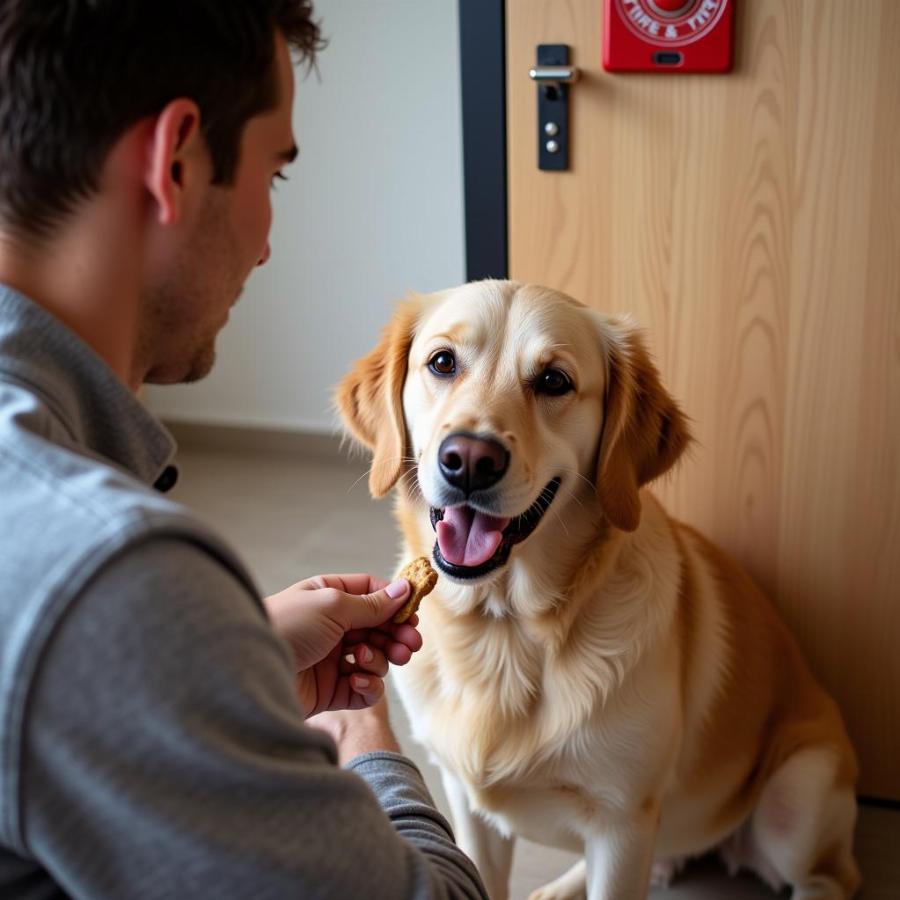The phrase “dog in fire” likely conjures up images of brave Dalmatians riding fire trucks, a classic symbol of firefighting history. While their courage and strength are undeniable, the reality is that every dog, regardless of breed, is vulnerable to the dangers of fire. It’s our responsibility as owners to prioritize their safety and be prepared to act quickly in an emergency. This article delves into crucial fire safety tips for dog owners, equipping you with the knowledge and resources to protect your furry friend.
Understanding the Risks: Why Fire Safety for Dogs is Paramount
Dogs, with their innate curiosity and love for exploration, might unknowingly wander into harm’s way, especially when it comes to fire. Their keen sense of smell can draw them towards smoke and fire, unaware of the potential danger. They also lack the understanding of how to react safely in a fire situation, making them susceptible to burns, smoke inhalation, and even death.
Proactive Prevention: Safeguarding Your Home Against Fire Hazards
Preventing a fire is always the best course of action. Here’s how to minimize risks and create a safe haven for your dog:
- Kitchen Control: Never leave cooking unattended, especially grease fires which can quickly ignite. Keep pot handles turned inward and store flammable items away from the stovetop.
- Electrical Awareness: Inspect electrical cords regularly for fraying or damage. Avoid overloading outlets and unplug appliances when not in use.
- Candle Caution: While candles create ambiance, they pose a significant fire hazard. Avoid using them around your dog, especially if they tend to jump or knock things over. Opt for flameless candles as a safer alternative.
- Fireplace Precautions: Install sturdy screens in front of fireplaces and never leave a burning fire unattended, especially with a dog present.
Preparing for the Unthinkable: Essential Fire Safety Measures
Despite our best efforts, unforeseen events can occur. Having a plan in place can mean the difference between life and death for your dog:
- Smoke Detectors and Fire Extinguishers: Install smoke detectors on every level of your home and test them monthly. Keep fire extinguishers readily accessible and learn how to use them properly.
- Fire Escape Plan: Map out multiple escape routes from each room, including windows that can be easily opened. Practice these routes with your dog regularly, using a leash for safe guidance.
- Designated Safe Spot: Assign a designated safe spot outside your home where family members gather in case of a fire. This ensures everyone knows where to go and prevents confusion during an emergency.
 Dog training with fire alarm sound
Dog training with fire alarm sound
Acting Decisively: What to Do if a Fire Occurs
If a fire breaks out, your priority is to evacuate everyone safely:
- Stay Low: Crawl low to the ground to avoid smoke inhalation, which can be just as dangerous as flames.
- Leave Immediately: Don’t waste time gathering belongings. Once you’re out, stay out and call 911 from a safe location.
- Never Re-enter: Never go back inside a burning building, even if your dog is still inside. Inform firefighters of their location and let them handle the rescue.
Post-Fire Recovery: Caring for Your Dog After a Traumatic Event
After a fire, your dog might be scared, anxious, or disoriented. It’s essential to provide comfort and support:
- Veterinary Checkup: Even if your dog seems unharmed, schedule a veterinary visit immediately to rule out any internal injuries or smoke inhalation effects.
- Patience and Understanding: Be patient with your dog as they adjust after the traumatic experience. They might exhibit behavioral changes, so provide extra love, attention, and reassurance.
- Creating a Sense of Security: Establish a familiar routine and provide a safe and comfortable space for your dog to help them feel secure again.
Beyond the Flames: Additional Fire Safety Tips
- Consider fire-resistant bedding and toys to minimize potential hazards.
- Keep leashes and collars easily accessible for quick evacuation.
- Microchip your dog and keep their information updated in case they get separated.
“When seconds count, having a plan can make all the difference,” says Captain Emily Davis of the Chicago Fire Department. “Knowing how to prevent fires, prepare for emergencies, and react swiftly can significantly increase the chances of survival for both you and your beloved pet.”
FAQs about Dogs and Fire Safety
Q: Can dogs sense fires before humans?
A: While dogs have a keen sense of smell, they may not always associate the smell of smoke with danger. Relying solely on their senses is not reliable; install smoke detectors for early detection.
Q: How do I train my dog to exit safely during a fire?
A: Practice your fire escape route with your dog regularly, using positive reinforcement and treats. Keep them leashed for control and associate the route with positive experiences.
Q: What if my dog is afraid of loud noises like fire alarms?
A: Desensitize your dog to the sound of fire alarms gradually. Start by playing the sound at a low volume and gradually increase it over time, rewarding them for calm behavior.
Q: Where can I find pet-friendly fire shelters in my area?
A: Contact your local animal shelter, veterinarian, or emergency management office for information on pet-friendly fire shelters and resources.
Keeping Your Canine Safe is Our Priority
At Beaut Dogs, we’re dedicated to providing you with the knowledge and resources to ensure your canine companion leads a happy, healthy, and safe life. For more helpful tips and guidance on all things dog-related, contact us at [email protected]. Let’s work together to keep our furry friends safe from the dangers of fire.